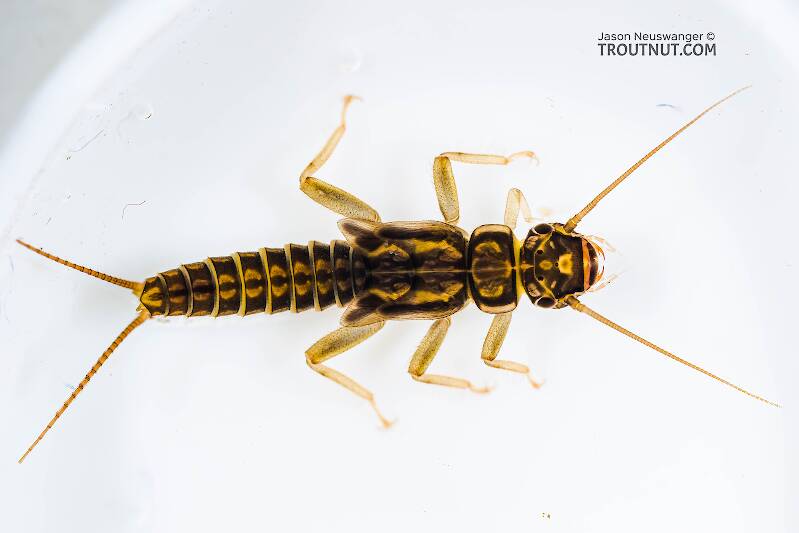
Salmonflies
Pteronarcys californica
The giant Salmonflies of the Western mountains are legendary for their proclivity to elicit consistent dry-fly action and ferocious strikes.


Stonefly Species Isoperla sobria (Yellow Sallies)
Species Range
Identification
Species ID from GBIFthe Global Biodiversity Information Facility
Source: The Isoperla Of California (Plecoptera: Perlodidae); Larval Descriptions And A Key To 17 Western Nearctic Species
Diagnosis. Mature male larvae of Isoperla sobria are distinctive with the following characters: the lacinia submarginal row (A) has 3 – 4 close set setae (Figs. 17 e, g-h), the completely enclosed inverted V shaped interocellar light area does not extend past posterior ocelli (Fig. 17 a), and basal segments 2 – 3 of the maxillary palpi have long, thin apically pointed setae (Fig. 17 a Inset). The interocellar light area was sometimes only a very small spot. It shares a similar dark comma shaped pronotal pigment pattern with the other species in the Isoperla sobria complex (Figs. 5 b, 11 b, 17 b, 19 b). Only Isoperla miwok lacked the multiple submarginal setae (A) character (Figs. 11 e, g-h).
Physical description
Most physical descriptions on Troutnut are direct or slightly edited quotes from the original scientific sources describing or updating the species, although there may be errors in copying them to this website. Such descriptions aren't always definitive, because species often turn out to be more variable than the original describers observed. In some cases, only a single specimen was described! However, they are useful starting points.
Description from GBIFthe Global Biodiversity Information Facility
Source: The Isoperla Of California (Plecoptera: Perlodidae); Larval Descriptions And A Key To 17 Western Nearctic Species
Male larva. Body length of mature larva 10 – 13 mm. Dorsum of head with contrasting pigment pattern and fine dark clothing setae, anterior frontoclypeus margin unpigmented; light M shaped pattern anterior to median ocellus connected to light frontoclypeus area by a median longitudinal light band, its width approximately equal to the posteromedian portion of the light M shaped pattern, lateral arms with irregular margins usually disconnected from median light area, directed posterolaterally, and extending to antennal bases; posterior ocelli with partially enclosed large light areas along outer lateral margins; interocellar area variable, usually partially light and shaped like an inverted V, completely enclosed by dark pigment and not extending past posterior ocelli, sometimes a small spot; occiput with irregular spinulae band extending from below eye to near median epicranial suture, not enclosed completely by dark pigment (Fig. 17 a). Lacinia bidentate, total length 901 – 1265 µm (Figs. 2 o, 17 e- h, Tables 2 - 4); submarginal row (A + B) with 5 – 6 setae, groups A-B interrupted by gap below subapical tooth (SAT) inner margin (Fig. 17 g); 3 – 4 submarginal setae (A) in a close set row beginning at base of apical tooth (AT), ending before reaching SAT inner margin, plus 1 thin marginal seta (TMS) adjacent to AT inner margin, sometimes obstructed from view by AT, submarginal setae (A), or broken, and 1 dorsal seta (DS) located below SAT inner margin, partially obstructed by SAT; 2 submarginal setae (B) located past SAT inner margin (Figs. 17 g-h); 10 – 17 marginal setae (C), initially longstout and widely spaced, sometimes several setae near end of row arranged in pairs protruding at dorsal and ventral angles, last few shorter and closer, blending into and difficult to differentiate from dorsal surface setae (Fig. 17 e); 21 – 58 ventral surface setae (D) scattered below submarginal and marginal setae, ending posteriorly at approximately ¾ the inner lacinia margin length, occasionally a few setae located below submarginal row striated (Fig. 17 f); dorsal surface setae (DSS) forming dense, laterally protruding, longitudinal band, concentrated at junction with marginal setae (C), ending at approximately ½ or a little more the lacinia length (Fig. 17 e). Galea with 12 – 23 setae in sparse ventral row, apex with 2 setae. Maxillary Palp segments 2 – 3 with curved, apically pointed setae (Inset, Fig. 17 e). Pronotum with large median light area bordered thick dark comma shaped bands typical of the Isoperla sobria complex, a range of irregular shaped faded light brown areas usually present between the dark commas and entirely covered by fine dark clothing setae, lateral margins with broad light bands (Fig. 17 b). Meso and metanotum with contrasting pigment pattern and fine dark clothing setae (Fig. 17 c). Legs with numerous fine golden clothing setae and scattered erect spines on outer surface of femora, erect spines longest and concentrated along dorsal surfaces; fine silky setae sparse on dorsal surface of femora, numerous and continuous on tibia (Fig. 20 o); distal femora and proximal tibia with distinct transverses bands. Abdominal terga with three distinct longitudinal dark stripes; wide light median band bisected with irregular shaped, dark median longitudinal stripe; lateral pair of dark longitudinal stripes about twice as wide as median dark stripe, usually not extending to lateral margins; numerous fine light clothing setae and erect spines scattered dorsally; posterior margin with scattered long and numerous short spines in a concentrated row (Fig. 17 d).
Source: The Isoperla Of California (Plecoptera: Perlodidae); Updated Male Descriptions And Adult Keys For 18 Western Nearctic Species
Male. Aedeagus: sclerotized posterior process absent; body of aedeagus typically with one anterior lobe and a pair of conical dorsal lobes (Figs. 15 a-c); in one male collected in copula, a small posteroapical lobe was present (Figs. 15 a-b); one long median patch of spinulae along posterior margin (Figs. 15 a-c). Abdominal terga 8 - 9, 9, 9 - 10: without stout spinulae or long stout setae. Posterolateral margins of at least abdominal segment 8 with scale-like setae clustered in brushes of several setae. Paraprocts: curved dorsally, length if straightened subequal to combined first and second cercal segments, tapering abruptly to blunt points (Fig. 15 c). Vesicle: lobe barely perceptible, at best represented by an area of lighter pigment (Fig. 15 d).
Start a Discussion of Isoperla sobria
Stonefly Species Isoperla sobria (Yellow Sallies)
Species Range
Common Names
Resources
- NatureServe
- Integrated Taxonomic Information System
- Global Biodiversity Information Facility
- Described by Hagen, H.A. (1874) Report of the Pseudo-Neuroptera and Neuroptera collected by Lieut. W. L. Carpenter in 1873 in Colorado. In: Annual Report on the United States Geological and Geographical Survey of the Territories, embracing Colorado, being a report of progress of the explorations for the year 1873. U. S. Geological Survey, Washington, D.C., pp. 571–606.

